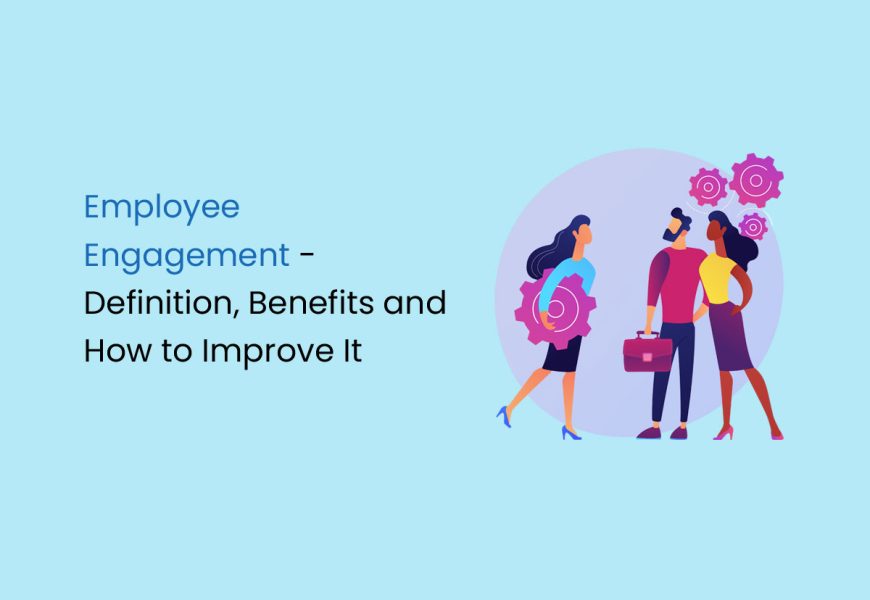Employee engagement has evolved significantly over the years. The focus now is on employers ensuring their employees feel fulfilled and are aligned with the organisation’s objective. The work culture has made revamping employee engagement plans essential, with leaders needing to develop strategies to engage their employees. Improving employee engagement is key to increasing productivity and retention rates.
This blog will cover employee engagement, its benefits, and successful strategies for improving it.
What is Employee Engagement?
Employee engagement is a workplace strategy that enhances employees’ emotional connection and commitment to the company, their role, colleagues, and the organisational culture. HR uses employee engagement tactics to bolster well-being and productivity across all company levels. It fosters motivation and ensures employees fully align with the company’s mission, objectives, and values, boosting its overall success. High engagement leads to higher job satisfaction, performance, retention and an overall positive employee experience.
Example of Employee Engagement
Tesla, Inc. was concerned about the high number of injuries at its Fremont car assembly plant. The electric car maker’s CEO, Elon Musk, used more transparent communication as an employee engagement strategy to improve safety. Musk asked employees to report every injury to him, without exception, so he could understand what was needed to prevent similar accidents from occurring in the future. He even worked on the production line with injured workers to see where safety improvements could be made. According to a company blog post, this initiative reduced the number of incidents that harmed workers by more than 50% in 2019 compared to 2018.
Importance of Employee Engagement
Employee engagement is the catalyst for unlocking employees’ full potential. Engaged employees are inherently more productive, resulting in higher output and superior work quality. However, despite the evident advantages of employee engagement, many organisations struggle to implement effective engagement strategies. Organisations must understand what drives engagement and how to measure it to cultivate a work environment where engagement thrives.
By prioritising engagement, companies can create a work environment where employees are invested in their roles and organisational objectives. This cultivates a culture of excellence and propels the company towards sustained growth and success, even in today’s ever-evolving business landscape.
Who Looks After Employer Engagement?
Managers have a crucial responsibility regarding employee engagement. They must ensure that employees understand their job responsibilities, receive the necessary support, and recognise how their work contributes to the organisation’s success. To achieve this, leaders should train managers to have frequent coaching conversations with employees. Unfortunately, most managers lack the skills to make these conversations meaningful and can be perceived as micromanaging without providing adequate guidance.
Therefore, it is not enough for leaders to tell managers to take charge of employee engagement and coaching. Instead, leaders should redefine the roles and expectations of managers and provide them with the necessary training, tools, and resources to coach employees effectively and meet expectations.
Leaders should also establish evaluation practices to enable managers to measure performance accurately, hold employees accountable, and provide guidance for future improvement.
Benefits of Employee Engagement
The benefits of engagement are as follows:
- Boosts Productivity: Engaged employees deliver high-quality work, are invested in their team’s success, and show higher levels of commitment and productivity. On the other hand, disengaged employees only work for a paycheck and put in minimal effort. Employees who are proud of their contribution are more likely to outperform others.
- Reduces Absenteeism: Engaged employees care about their team’s success, so they work hard and invest quality time to ensure it. As a result, they usually have lower absenteeism rates because they want to achieve their goals more quickly.
- Enhances Company Culture: Employee engagement fosters a pleasant, vibrant, and productive workplace culture. When employee engagement is part of a company’s culture, it fosters a work environment that depends on core values. Engaged employees model good behaviour that promotes a productive work culture.
- Increased Retention: Engaged employees are less likely to leave their jobs as they feel valued, challenged and fulfilled. They have no reason to seek a job elsewhere and are happy when they feel valued.
- Better Business Outcomes: Engaged employees work efficiently, achieve their targets, and drive customer satisfaction and loyalty, resulting in better business outcomes. Highly engaged organisations are more profitable than their peers.
- Better Employee Health: An engaged workplace fosters well-being by prioritising employee needs and encouraging work-life balance. The workplace can become a supportive environment for employees’ physical, emotional, and mental well-being.
- Attracts Top Talent: Companies with demonstrably high employee engagement attract top talent by creating a work environment that is supportive, inclusive, and fosters a sense of belonging. Such companies often have a strong reputation for employee satisfaction, which can help attract even more top talent in the future.
Types of Employee Engagement
Some initiatives that foster employee engagement are as follows:
- Onboarding: A good onboarding process helps shape a company’s culture and fosters camaraderie among new hires. Interactive and flexible training, team-building activities, and engagement can help new hires understand the organisation’s values and goals and connect with colleagues. Companies can increase employee engagement, retention, and productivity by making onboarding enjoyable and engaging.
- Setting Goals and Rewards: Goal setting is a proven tool for boosting employee enthusiasm and performance. This involves setting weekly, monthly, or annual goals, recognition, and rewards for hard work. Organisations can drive better results and motivate and engage their workforce by prompting employees to achieve their goals.
- Teamwork: Some organisations encourage team-building activities to foster a workplace environment. Teams encourage people to participate actively in decision-making, making them feel valued and heard.
- Career Development Initiatives: Providing opportunities for professional development, including company-paid education and continuous learning, demonstrates a company’s commitment to employee growth.
- Work-life Balance: Flexible hours, on-site childcare, and other work-life benefits demonstrate a company’s support for its employees’ personal and family obligations. These initiatives can improve morale and attract and retain talented individuals seeking work-life balance.
- Clear Communication: Regular and clear communication through one-on-one check-ins and pulse surveys is vital in fostering employee engagement. These practices facilitate transparency, active listening and feedback, essential elements of a thriving workplace culture.
- Purpose-Driven Work: Employees who find their work meaningful are more engaged. When a company conveys its mission and recognises hard work, employees feel more appreciated and necessary.
What Drives Employee Engagement?
Companies often make the mistake of thinking that employee engagement is just about making their employees happy. They could improve employee satisfaction before an engagement survey. While employee engagement surveys can help measure staff engagement, it’s not enough. People want a sense of purpose and meaning from their work and recognition for their skills. The key drivers of employee engagement are as follows:
- Purpose
- Development
- A Manager who Cares
- Ongoing Conversations
- Focusing on Strengths
Employees need more than a temporary feeling of satisfaction and a good salary to stay engaged and productive. They want to feel that their work is meaningful and that their manager values them. A good manager can coach them to reach their full potential, essential for employee engagement.
How to Measure Employee Engagement
Measuring employee engagement is crucial for maintaining and improving it. Various methods can be employed to gauge employee engagement effectively:
- Employee Engagement Surveys: These surveys provide quick insights into employee sentiments. Different types, such as long-form comprehensive surveys, pulse surveys, and employee lifecycle surveys, offer varied perspectives on topics ranging from overall satisfaction to specific workplace concerns. Surveys should cover entire organisations, groups, teams, and individuals, with questions crafted by organisational psychologists and data scientists.
- Key Performance Indicators (KPIs): KPIs offer measurable metrics to assess employee engagement. These may include turnover rates, employee satisfaction index, likelihood to recommend the organisation, absenteeism, intent to stay, sense of accomplishment, internal promotion rate, inclusion, retention, and well-being.
- Focus Groups: These bring employees together to discuss specific topics in-depth, providing real-time feedback on various aspects of engagement.
- Informal Feedback: Regular meetings between managers and employees can offer valuable insights into engagement and satisfaction levels. When assessing employee engagement, consider asking questions such as:
- Do employees arrive early?
- Do groups of employees eat lunch together?
- Are there organised group outings or community service projects?
- Are employee turnover rates decreasing?
- Do employees recommend the company to friends?
How to Improve Employee Engagement
Some ways to improve engagement are as follows:
- Understanding Satisfaction and Engagement: Employee satisfaction refers to meeting goals without exceeding them, while engagement involves a deep connection and motivation towards work, with employees actively collaborating to achieve organisational goals. Recognising this distinction is vital for fostering a highly satisfied workforce.
- Setting Achievable Goals: Communicate organisational goals, mission, and vision to employees, particularly during onboarding and training. Employees feel motivated and engaged when they understand how their roles contribute to organisational success.
- Building a Strong Culture: Create a workplace culture that promotes good communication and ensures employees feel comfortable and happy. Conduct team-building activities, encourage volunteering, and celebrate individual and team successes to foster engagement.
- Facilitating Feedback: Establish an environment that welcomes regular feedback from employees, both anonymously and openly. Encourage an open dialogue between employees and leaders to identify ways to enhance motivation and engagement.
- Showing Appreciation: Recognise and appreciate employee contributions to boost motivation, productivity, and performance. Implement performance reviews and encourage peer-to-peer recognition to reinforce engagement and a positive company culture.
- Providing Necessary Resources: Equip employees with the necessary tools and resources to succeed. Solicit feedback to identify and address any lacking resources promptly, ensuring employees can effectively contribute to organisational success.
- Promoting Learning: Foster a culture of continuous learning by giving opportunities for skill development and career growth. Offer training, seminars, and upskilling programs to empower employees to thrive and grow alongside the organisation.
- Creating a Stress-Free Environment: Cultivate a work environment free of fear and stress by empowering employees to make decisions and take calculated risks without fear of punishment. Encourage a positive approach that nurtures employee engagement and personal growth.
- Conducting Engagement Surveys: Regularly conduct employee engagement surveys to gauge engagement strategies’ effectiveness and gather employee feedback. Prioritise open and honest communication to ensure employees feel valued and heard.
How to Maintain Employee Engagement
The following can help in maintaining employee engagement:
- Utilise Engagement Software: Use software to monitor KPIs and gain insights into engagement levels.
- Promote Open Communication: Foster transparent communication channels among employees, managers, and leaders.
- Regularly Review Surveys: Continuously update survey questions to address changing concerns and priorities.
- Utilise Feedback and Metrics: Act on feedback and performance data to drive improvement initiatives.
- Offer Work-Life Balance Incentives: Provide flexible work arrangements and other incentives to support work-life balance.
- Invest in Wellness: Prioritise employee wellness with fitness programs, mental health support, and healthy food options.
- Create a Positive Culture: Cultivate a positive work environment through recognition, collaboration, and inclusion initiatives.
Technology for Employee Engagement
The following tools are available for employee engagement:
- Employee Engagement Software: These platforms solicit employee feedback, set goals, reward performance and collect engagement analytics. They include survey tools, recognition features, feedback mechanisms, talent reviews, and goal-setting functionalities.
- Performance Management Software: This software aligns work with organisational goals to enhance productivity. It integrates with workforce analytics to identify areas needing greater engagement focus and tracks individual employee goals. Additionally, it can monitor employee engagement through social media and sentiment analytics tools.
- Communication and Collaboration Platforms: These platforms offer features such as video conferencing, instant messaging, and collaboration capabilities, fostering connectivity and engagement among employees.
- Wellness Software: These platforms provide resources and interactive programs to support employees’ physical and mental well-being, aiding in stress management and overall health.
The Employee Engagement Model
There are four levels in the model. They are as follows:
Growth
- Challenge them
- Help them review my contributions
Teamwork
- Help build mutual trust
- Help them feel proud
- Help them see their importance
- Hear them
Individual Contribution
- Help them grow
- Care about them
- Help them see their value
- Know them
Basic Needs
- Free them from unnecessary stresses
- Focus them
To create a supportive work environment, managers must address three foundational levels. These levels provide a roadmap for managers to motivate and develop their team members while improving their performance. Managers should ensure that their employees have what they need to do their jobs and meet needs on all levels. They should work with team members to identify needs and obstacles and take action before challenges impact their performance. This process should be ongoing and not considered as distinct phases. Managers should explain expectations to their employees and provide them with the necessary materials and equipment.
Conclusion
Employee engagement is essential for organisational success. It impacts productivity, retention, customer satisfaction, and overall business performance. By promoting a culture of engagement, organisations can create a motivated and committed workforce that aligns with the company’s goals and values. Investing in employee engagement benefits both employees and the organisation’s long-term success.
Frequently Asked Questions
What are the five C’s of employee engagement?
The five C’s of employee engagement are:
- Care
- Connect
- Coach
- Contribute
- Congratulate
What is the definition of employer engagement?
Employer engagement primarily focuses on connecting with employers to create opportunities for project participants, including work placements and job opportunities.
What is the significance of employee engagement?
Employee engagement is crucial as it reduces turnover and improves productivity, customer service, and profits.
What are the four E's of employee engagement?
The four E’s of employee engagement are:
- Enablement
- Energy
- Empowerment
- Encouragement
What are employee engagement examples?
Employee engagement can be demonstrated through various indicators such as arriving at work with a clear sense of purpose, having a solid commitment to the organisation, being dedicated to performing well, maintaining a collaborative attitude, communicating effectively with co-workers and leaders, and possessing the ability to give and receive feedback positively.
What are the three key drivers of employee engagement?
The top three drivers of employee engagement are:
- Purpose
- Autonomy
- Relationships
How to do employee engagement?
You can engage employees by:
- Model your Company values and Mission
- Prioritise feedback
- Concentrate on engaging management
- Coordinate volunteer opportunities
- Prioritise physical and mental health
- Recognise top performers and reward achievements
- Conduct Frequent employee engagement surveys














